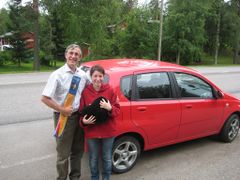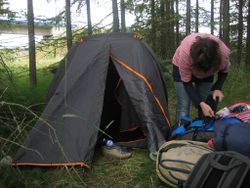Difference between revisions of "Finland"
| Line 106: | Line 106: | ||
[[trash:Finland]] | [[trash:Finland]] | ||
[[wikipedia:Finland]] | [[wikipedia:Finland]] | ||
| + | [[nomad:Finland]] | ||
[[de:Finnland]] | [[de:Finnland]] | ||
[[fi:Suomi]] | [[fi:Suomi]] | ||
| − | + | ||
| + | {{move_to_nomadwiki}} | ||
Revision as of 18:01, 31 January 2015
| Information | |
| Language: | Finnish, Swedish; recognised regional languages: Sami |
| Capital: | Helsinki |
| Population: | 5,301,701 |
| Currency: | Euro (€) |
| Hitchability: | <rating country='fi' /> |
| Meet fellow hitchhikers on Trustroots | |
| <map lat='64.8' lng='25.9' zoom='4' view='0' width='300' height='350' country='Finland'/> | |
| Check out hitchhiking spots on Hitchmap | |
Finland is a part of the Northern Europe and one of the Nordic countries. It is a member state of the European Union as well as the Schengen Agreement. Its neighbouring countries are Sweden, Norway and Russia, but the most probable transit country on your way hitchhiking there from Southern Europe is Estonia as the Via Baltica (E67) road connects Finland with Prague via the Baltic States and Poland.
It is illegal to hitchhike directly on motorways (moottoritie) and some two-land expressways roads (moottoriliikennetie) in Finland. You can recognize these from the green signs. On these roads, you can hitch from on-ramps (which often have bus stops that drivers will stop at) and petrol stations. The cars cannot stop in crossing areas, and some drivers who disobeyed this rule and picked up hitchhikers have been fined.
In the south, it is a good idea to avoid motorways and opt for smaller local roads. Though there is less traffic, there is more room for cars to stop. Finnish drivers will only stop where they feel it is safe, so try to thumb at bus stops.
Contents
Regions
Border crossing
There are no border checkpoints between Finland, Sweden and Norway. You can cross these borders without stopping.
From/to Sweden
Ferries to Stockholm go from Helsinki and Turku. The latter is considerably cheaper. Both ferries also stop in Maarianhamina (Ahvenanmaa), or Mariehamn (Åland), as its Swedish-speaking population calls it. It is possible to buy a deck ticket to Maarianhamina only and yet ride the whole way as nobody is checking. The two companies which run ferries between Finland and Sweden are Viking Line and Silja Line. Both of the companies are focused on bringing the customers a cruise-experience, and are bound to be tacky. Viking Line sells cheaper tickets without a cabin, too, which would be rather useless on the daytime trips between Turku and Stockholm anyway. As of August 2009, a morning ferry from Stockholm to Turku costs 15 euros, and Stockholm-Helsinki - 55 euros (both without a cabin, although prices vary according to season and special offers can put the price belowe 10 euros).
Silja Line is the posher of the two, and thus more expensive. It's still tacky, though.
The Viking Line cruise ships have free tourist maps of Turku at their information desks on board. Be aware, though, that if you take a daytime cruise (which is about half the price), you will arrive in Turku at night. During the autumn, winter and early spring that means no daylight which is no help for hitchhiking. In winter nights, extremely cold temperatures might occur as well.
A decidedly more exciting option is to do island hopping on the small car ferries running from Turku to Maarianhamina. For footpassengers this option is free. You can continue to Sweden with one of the above mentioned companies or "Eckerö Lines"
There are also ferries crossing the Bothnic Gulf from the Finnish city of Vaasa to the Swedish city of Umea and vice-versa. The ferry goes eight times a week (see the schedule here). Crossing will cost you around 30 euro but it is a quite comfortable trip.
From/to Estonia
There is no land connection between Finland and Estonia. There are many daily ferries from Helsinki to Tallinn. It takes 1-3 hours (most ferries 2h), costs about 20-50 euros (the cheapest tickets you should try to book in advance).
You can hitch sail and motor boats from Tallinn and Pirita marinas during the summer. Especially Sunday mornings are good when Finns return from their weekend trips.
Cars pay also per passanger so it's not possible to hitch a car to the ferry for free.
Ferry companies
Language
The language most people in Finland speak is Finnish which isn't a Scandinavian language. The country is officially bilingual as there is a large Swedish-speaking minority on the west coast of Finland. Most people speak English too, so most of the foreign hitchhikers won't have communication problems in Finland.
Some older people, however, might have no English language knowledge at all, so you might as well learn some basic Finnish phrases. Note, that with a knowledge of Swedish, however, you can come pretty far (it is useful all over Scandinavia).
Useful Finnish expressions for hitchhikers
- Hello = Terve
- Hi = Moi or Hei
- Hitchhiking = Liftaaminen
- To hitchhike = Liftata
- A ride = Kyyti
- Thank you = Kiitos
- Where are you driving to? = Minne ajat?
Safety
Hitchhiking is quite safe in Finland. As always, common sense is your friend.
Sleeping
Like the other Nordic countries, Finland has everyman's right (jokamiehenoikeus) meaning that it is allowed to camp on any land provided that you stay a few hundred metres from houses, do not start a fire, and do not more than one night in any given place. While everyman's right technically doesn't apply inside of towns and cities, there is usually no problem with camping in isolated areas of parks -- even if police see you, they are more concerned with gypsies than with backpackers.
In Southern Finland and the Åland Islands, the forests and grassy areas are full of ticks, so wear clothing that covers your legs and check occasionally that you haven't been bitten.
Culture
Hitchhiking used to be popular in the 70's and 80's, and many drivers will tell the hitchhiker(s) they've hitched themselves back in their days. Nowadays this practice is rather rare among Finns, but there are always some, especially in summer time around music festivals. Hitching in Finland might be difficult during the winter time because lack of daylight.
Links
- Finnish Hitchwiki
- IRC Channel Liftari @ IRCnet
- Finnish hitchhikers FB group
- Hitchhiker's guide to Europe − a hitchhiking site by a Finn
- Liftausvinkkejä − hitchhiking tips in Finnish
- Hitchbase page for Finland with somewhat outdated tips for locations
- Lonely Planet − Finland eBook (2003) preview
- Kyydit.net - rideshare network for Finland
- Kimppa.net - another rideshare network for Finland
> 500.000: Helsinki
100.000-500.000: Tampere • Espoo • Vantaa • Turku • Jyväskylä • Oulu • Lahti • Kuopio
50.000-100.000: Pori • Seinäjoki • Hämeenlinna • Rovaniemi • Vaasa • Lappeenranta • Kouvola • Kotka • Salo
20.000-50.000: Mikkeli • Porvoo • Kokkola • Hyvinkää • Nurmijärvi • Lohja • Rauma • Järvenpää • Kajaani • Tuusula • Kirkkonummi • Kerava • Nokia • Kaarina • Ylöjärvi • Kangasala • Raseborg • Riihimäki • Imatra • Vihti • Savonlinna • Sastamala • Raisio • Varkaus • Jämsä • Kemi • Raahe • Tornio • Iisalmi • Hollola • Hamina • Siilinjärvi • Valkeakoski • Lempäälä • Äänekoski • Heinola • Mäntsälä
Albania • Andorra • Austria • Belarus • Belgium • Bosnia and Herzegovina • Bulgaria • Croatia • Cyprus • Czech Republic • Denmark • Estonia • Finland • France • Germany • Greece • Hungary • Iceland • Ireland • Italy • Kosovo • Latvia • Liechtenstein • Lithuania • Luxembourg • North Macedonia • Malta • Moldova • Monaco • Montenegro • Netherlands • Norway • Poland • Portugal • Romania • Russia • San Marino • Serbia • Slovakia • Slovenia • Spain • Sweden • Switzerland • Turkey • United Kingdom • Ukraine • Vatican
trash:Finland wikipedia:Finland nomad:Finland
| Some parts of this article unrelated to hitchhiking should be moved to Nomadwiki.org instead. edit this article! |


